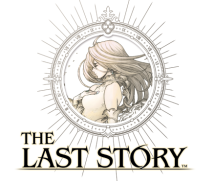4. Set In A Single City
Turning now to the world in which The Last Story is set, the action takes place in a single city, doesn’t it?
That’s right. Basically, there’s a single city called Lazulis City.
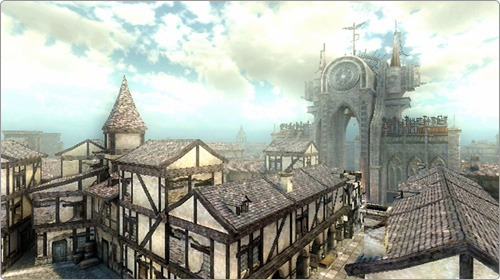
I was genuinely bowled over by the attention to detail and depth of this city’s rendering. What was the original intention behind this city?
The player is going to spend a lot of time in this city, so I wanted them to like it.
What it reminded me of was Wuhu Island, which is where Wii Fit Plus9 and Wii Sports Resort10 are set. 9 Wii Fit Plus is a fitness game released for Wii in October 2009 and is an enhanced version of Wii Fit with a wide range of new content. 10 Wii Sports Resort was a sports game released for Wii in the summer of 2009. It is designed to be used with the Wii MotionPlus accessory.
I see.
Wuhu Island originated in Iwata Asks: Wii Sports Resort. In other words, by visiting the same place again and again, you’d see more and more of its features and learn more about it.
That’s exactly the thinking behind it. With a location that’s familiar to the player, they can pick up on even the slightest difference. It has the advantage of making it possible to communicate even very subtle nuances. For example, early on one of the passers-by will barge into you with their shoulder and say: ‘Hey! What are you doing?’ But then when the hero has become a little more established, they’ll say: ‘Oh, I’m terribly sorry!’ That’s a really nice feeling. But it’s such a huge place, with so much going on, that even I still find myself getting lost down some out-of-the-way backstreet. (laughs)
So even you get lost? (laughs)
There are places I still can’t seem to get to. Then when I go down the backstreets, I’ll pass someone who’s always doing their washing, and I can’t help wanting to coax some kind of reaction out of them.
There is a lot of graphical content specific to the city, such as people dancing in the streets, playing the accordion, or sitting at the edge of the fountain.
You’ve made it so there’s a lot going on even in places you wouldn’t normally go to. Did you request all of these things, Sakaguchi-san?
I’d just casually say things to the team. So I’d be walking down a street during the debug phase and say: ‘Ummm… Isn’t there something that happens here usually?’ (laughs)
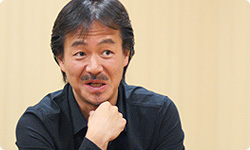
So you’d say that and then just leave. (laughs)
And then the team would feel they had to do something! (laughs) By repeating that process, the amount of detail increased.
So the city’s distinctive richness came about as a result of that sort of cumulative process.
It did sometimes work the other way round though, didn’t it? You’d say: ‘I never said anything, but now look at this!’
Yes, you’re right.
There were areas that the dev team were more than happy to add detail to.
No doubt that came out of that desire to surprise Sakaguchi-san which you mentioned earlier. The team making the city must have shared that desire. I think for those of us who make things, the fundamental drive is to create something other people will respond to. When everyone working on a project shares this drive and they’re all working towards the same goal, a huge amount of energy is unleashed, creating something really special.
Yes, that’s right.
But if different members of the team are pulling in different directions, the unity of the game’s world will be destroyed.
I think that’s true. Even with just a single city, there is a world with its own feel. I’m sure that if the staff are trying to impress and surprise each other, and just having fun with it, the city will be much better for it.
Are there any aspects of the game that you’re particularly keen for players to see?
Things I’m keen for them to see…? Well, not really.
Not really?
That’s right.
I suppose you can say something like that because you have a real sense of achievement after all you’ve put into the game. I must say, I was impressed by your comment just now.
Oh really? (laughs) Well, I think people will find when they come to play the game that there’s a certain feel to it that runs throughout the entire game. That’s not something that was planned particularly. It might be the conversations characters have, or the energy in the city... All of these small details gel together successfully. The unique feel of the game served as a source of energy for me, even though we were the ones who’d made it in the first place. (laughs) That’s what I find interesting about The Last Story. I’d be very happy if players also felt that this game has a certain energy about it.
The entire game definitely has a certain vitality to it.
Where does that vitality come from, that feeling that gets the player excited? Do you think it comes from the battle system, or the way the characters interact with each other?
Perhaps one of the factors is that when you’re playing the game, you aren’t presented with clear signs: That’s the correct answer!’ That may be what makes it so exciting. Naturally, there’s a story at the core of the game, but there’s also the sense you get: ‘I can just play in the way I want and it’ll be fine…’
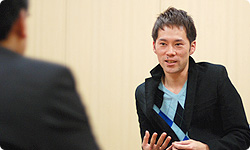
So you think there’s a sense of achievement you get when you take things into your own hands, and have the excitement of playing in your own way, rather than just following a pre-determined route. I think it’s this feeling of creating your own path which gives the whole game that vitality, combined with the atmosphere of the city, and the dialogue between characters.
Right. I also think another element that makes the battles more enjoyable is that your enemies will move in a similar way to you. You’ll sometimes get an enemy skeleton leaping right over your ally’s head.
Wow!
It may be an enemy, but it looks really cool! So you’ll see that and want to do the same. The system means that your enemies look cool and, who knows, you may even fall for them! (laughs)
So enemies don’t just show up in order to be defeated, do they?
The way the enemies move, along with the camera angle we discussed earlier, adds to a general feeling of freedom, of not being locked into a set way of playing. You can actually dress the characters as well, so there could be a really dramatic point in the story where your character is dressed in a completely outrageous way! (laughs)
I see.
Fujisaka-san really put a lot of effort into those clothes. When we initially set the big goal of making it possible to change the characters’ clothes, it made life really tough for him.
I thought: ‘Uh-oh. This is no good.’ But when I said to myself that I had no way but to do this, I felt like, “it can’t be too bad after all.”. (laughs)
So you switched your mindset! (laughs)
At the start, I had certain ideas in mind: ‘Right, I want this character to look like this when he speaks.’ I then designed their clothes in line with that. But as I started to work on it, I realised that changing the character’s clothes would be kind of fun too. (laughs)
Coming up with the combinations of costume changes was a lot like a puzzle, wasn’t it?
Another thing that I was really surprised by was the fast forward feature that lets you watch cut scenes at twice the normal speed. I thought: ‘But this is Sakaguchi-san, who places such importance on drama, and he’s letting you fast forward things…?’
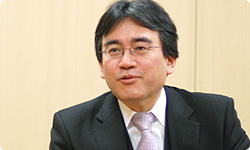
It’s true, you can fast forward scenes. It’s different from just being able to skip the whole scene and interrupt the flow of the story. What I like about fast forward is that you can still see the subtitles and follow the story.
Is that something you’d been wanting to do for a while?
Yes, it was something I was determined to do. Ah, yes! That’s it! What I really want the player to look out for is this fast forward function! (laughs) It’s my favourite feature. It’s amazing!
Amazing?
Sakaguchi-san had come up with this idea from quite an early stage.
This... Well, it may have been the biggest shock of all for me! (laughs)
I didn’t want to force people to watch the story. I wanted to let people follow it at their own pace…
And what could be better than a fast forward feature? (laughs)
